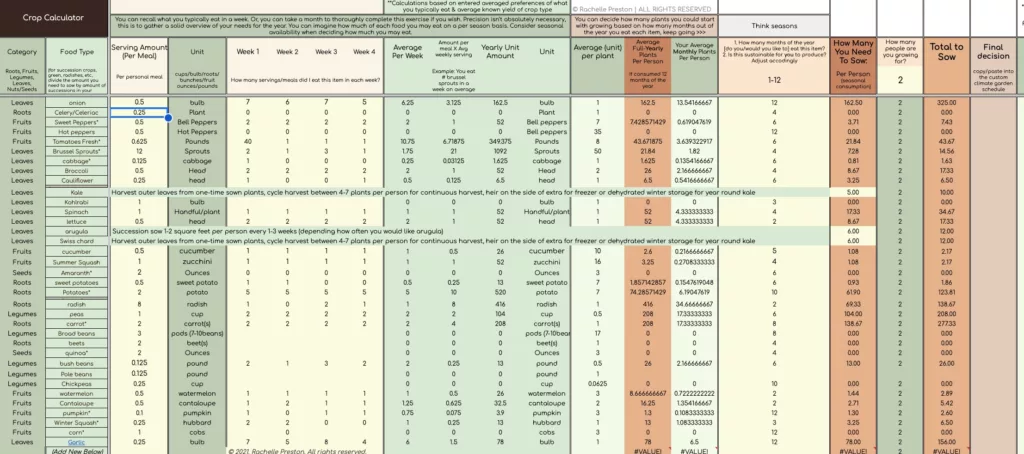This post may contain affiliate links. If you use these links to buy something we may earn a commission. Thanks.
To make the most of your resources, energy, and garden space, you’ll need to calculate an accurate number of plants to grow for your family.
Every family is different which is why a general chart doesn’t cut it when deciding how much to plant per person.
I made a process and a calculator so you can grow a custom garden based on what your family actually eats.
In this article, I’ll walk you through the process of determining the best number you can enter into a crop calculator, or direct you on how to calculate crops manually.
Related: Best Vegetable Garden Spreadsheet (Custom Planting Schedule)
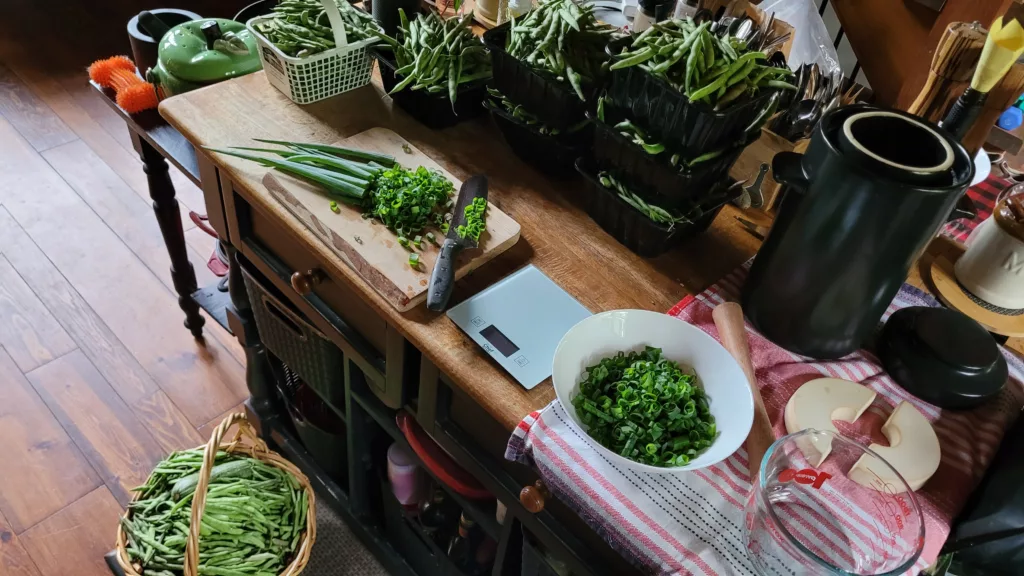
I started doing this after the year I wanted to grow a dozen varieties of tomatoes and 16 varieties of peppers. At the time, my eyes were dazzled by every packet of unique heirloom vegetables to grow.
So I grew 8-12 of each variety and by the end of it, I had 120 tomato plants and 100 pepper plants. While I had the room, it was unnecessary labor to stake too many tomatoes and peppers while not having enough peas, brussel sprouts, or greens.
Before you go on to answer questions like; how much will fit in your garden, what grows well in your climate, or what you’ll eat fresh versus preserved—we need to back up a bit and start from the beginning!
Deciding what to grow in the garden begins on your plate.
To help gather a sense of what you generally put on your plate, begin by looking around your home.
1. What food is in your home right now?
- What growable foods do you have in your home right now?
At current from the grocery store, we have 3 bundles of asparagus, a head of cauliflower, frozen corn, frozen peas, 2 cabbages, onions, sweet peppers, jalapenos, canned diced tomatoes, tomatoes sauces, zucchini, and cucumbers. We don’t have fresh tomatoes because they just don’t taste like garden tomatoes and are very expensive.
Related: Save Money & Grow the Vegetables That Cost You Most
From last year’s garden, we have a few jars of sour kraut, jars of fermented green beans, dried beans, fermented garlic, frozen tomato sauces, frozen hot and sweet peppers, garlic, dirty carrots, turnips, and beets. We have (and use) dried onions, chamomile, lemongrass, sage, summer savory, and calendula.
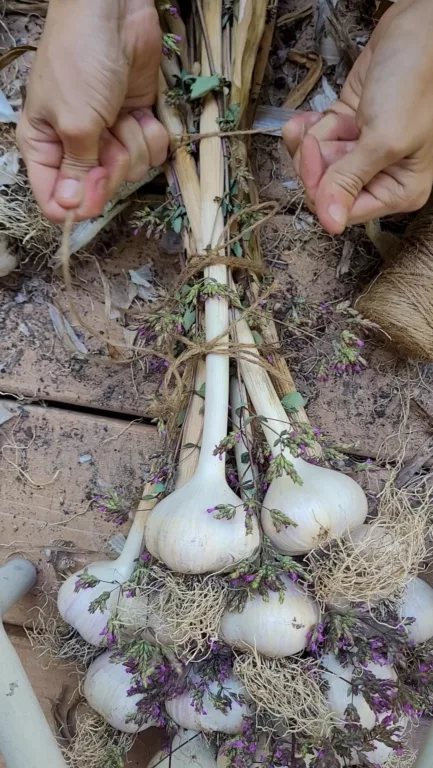
You may be wondering, why would we have anything from the grocery store, if we have supposedly gone through this process and ‘grown a year’s worth of food?!’
It’s because, just because you go through this process and determine how much to grow for your family food supply—you likely aren’t going to grow all of it today, or if you do, you might not master everything all in one shot.
I actually recommend that you figure out what it will take to grow a year of food for your family, and begin by mastering a year’s worth of the crops you know how to grow well.
For the crops you don’t know how to grow yet, start with a couple of each and learn the plant before going all in at once.
Not only do you need to build up your skill with growing a particular crop, but you also need to build up your environment to provide for its needs.
We had differing degrees of success between crops:
- Our most successful were tomatoes, peppers, welsch onions, cabbages, brussel sprouts, carrots, turnips, beets, and green beans. We have a year’s worth of these.
- Our big failures due to inadequate soil and pest protection were potatoes, squashes, cauliflower, broccoli, corn, bulb onions, amaranth, celery, lettuce, and broad beans. We didn’t get much out of these.
Although we had the room, we didn’t have the time or resources to provide an adequate environment to grow everything successfully last year. And that’s okay! Every year, we build.
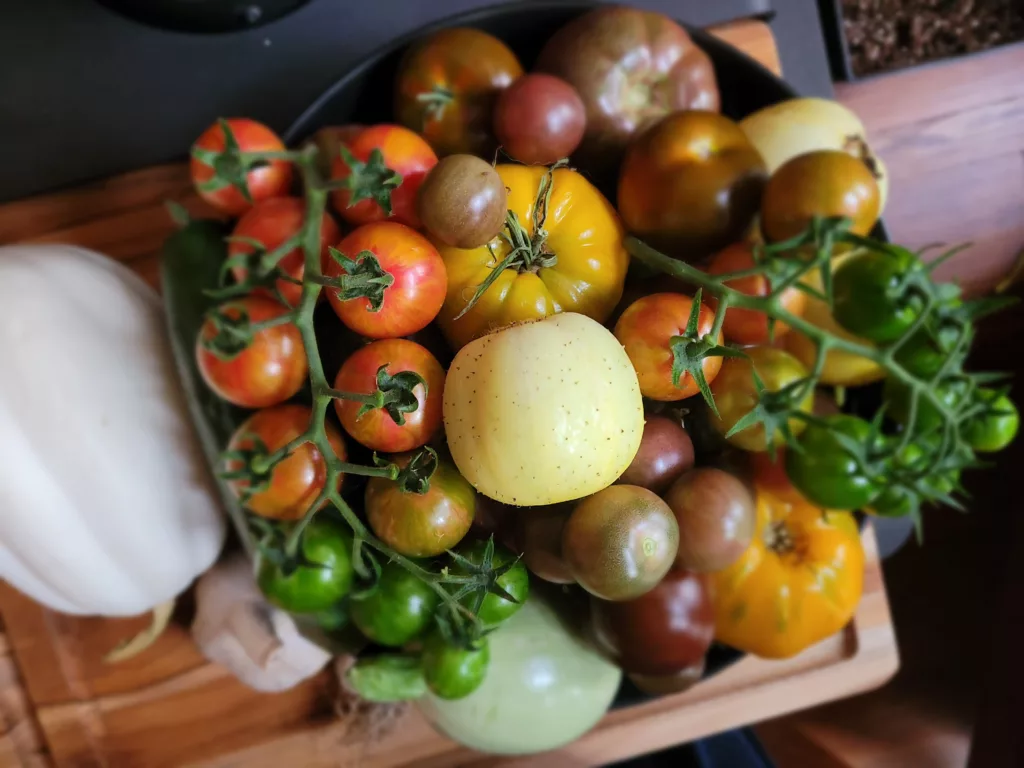
2. How often do you eat each fruit or vegetable?
Which of these foods do you eat daily? Weekly? Monthly?
Next, make a priority list.
The food you eat most often is under ‘daily’, the foods you eat often but not necessarily every day are under ‘weekly,’ and the foods you eat sometimes are under ‘monthly’.
You can even add a ‘yearly’ food list for things like cranberry sauce or brussel sprouts if you only eat them at Thanksgiving, for example.
The below chart is the frequency my family tends to eat each food.
| Daily | Weekly | Monthly |
| Onions x325 | Turnips x48 | Cucumber x35 |
| Garlic x312 | Peppers x48 | Broccoli x32 |
| Hot peppers x273 | Peas x48 | Brussel sprouts x28 |
| Potatoes x200 | Zucchini x48 | Beets x24 |
| Beans x96 | Sweet potatoes x42 | Melons x18 |
| Tomatoes x96 | Cabbage x36 | cauliflower x16 |
| Corn x88 | Celery x36 | Squash x12 |
| Carrots x64 | Leafy greens x36 | |
For each crop, you’ll want to figure out how many times each food is used in a meal per year.
Keep in mind, you may only eat certain foods when fresh, as they are in season. To eat them from the garden out of season, you’ll have to want to eat them in a way they can be preserved.
How might this affect the way you eat food? Over time, those answers will become clear as you try new things. So bookmark this page so you can do recalculations every year as your eating habits change.
3. What staple foods do you eat in high quantities?
Frequency is one thing, and serving size is another.
A staple food is a dense food.
From the chart above, hopefully, you’ve made your own, pick out and list all the staple foods you eat in large quantities.
For us, that looks like potatoes, sweet potatoes, beans, corn, root vegetables, cabbage, and squash. Your staples may look different than mine.
Onions, garlic, and peppers are flavor staples.
Now, the question here is, which are the easiest to grow in large quantities?
We found out pretty quickly that while we can grow a year’s worth of green beans, we certainly wouldn’t be growing a year’s worth of dry-shelled beans anytime soon. We simply eat too many.
So this is about thinking about how we can adapt to one day meet the goal of growing our own food.
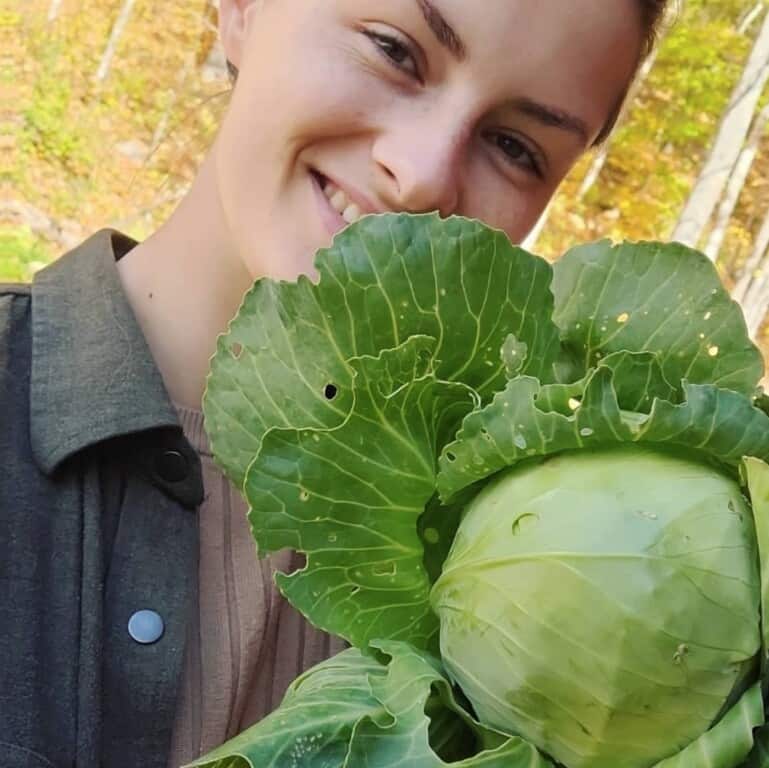
What major staples do you eat that you can grow?
And, if you can grow it, would you eat more of it (potatoes perhaps?) than you eat pasta or rice at current?
Determine how often you’ll eat each staple if you no longer had a grocery store. These numbers can be used in your calculation to gather a sense of the reality of growing your own food.
We would likely eat potatoes, onions, and beans every day. Then rotate between cabbage, squash, and various root vegetable staples.
4. What is a typical serving size?
Next, you’ll need to decide on the average serving size, per person, per meal for each vegetable.
Does everyone eat varying amounts? Calculate the average!
For example:
- I eat 8-12 brussel sprouts per meal: Average 10
- Chris eats 10-14 sprouts per meal: Average 12
- Our parents eat 6-8 sprouts per meal: Average 7
7+7+12+10 = 36
36/4 = 9 brussel sprouts on average per person, per meal.
For onions, I usually use 2-3 in a meal for 2-4 people. So I just average half an onion per person per meal without any meticulous math.
Do this with each vegetable you want to grow.
| Vegetable | Serving Size Per Person Per Meal |
| Onion | 0.5 onion |
| Celery | 0.25 stalk bundle |
| Sweet Peppers | 0.5 pepper |
| Hot peppers | 0.5 pepper |
| Tomatoes | 0.625 lbs |
| Brussel sprouts | 12 sprouts |
| Cabbage | 0.125 cabbage |
| Broccoli | 0.5 floret |
| Cauliflower | 0.25 head |
| Cucumber | 0.5 cucumber |
| Zucchini | 1 zucchini |
| Potatoes | 2 potatoes |
| Sweet Potatoes | 1 potato |
| Peas | 1 cup |
| Carrots | 2 carrots |
| Beets | 2 beets |
| Turnips | 2 turnips |
| Green beans | 0.125 pound |
| Melons | 0.5 melon |
| Squash | 0.25 squash |
| Corn | 1 cob |
| Garlic | 0.25 bulb |
With a good sense of what you eat and how often you eat it, you should be able to add up how much of each vegetable you’ll need.
5. How many plants do you need per person?
Finally, you’ll need to know the average yield per crop for the right number of crops to sow.
Since not everything is as easy as 1:1 carrots and onions, the average crop yield is a topic beyond this post, but I have articles for several vegetables that reveal the average yield per plant. I also have a crop calculator you can use instead of sifting through information.
- Calculate How Many Tomato Plants Per Person for Your Family
- How Many Peppers to Plant Per Person (Calculate Your Needs)
- How Much Garlic to Plant for a Year’s Worth of Family Use (+ free replanting garlic calculator)
- Calculate How Many Brussel Sprouts to Plant for Your Family
I used the crop calculator to put together our family’s results in this chart:
| Vegetable Crop | Single Serving Size (amount per person) | Meals Per Year (frequency) | Plants Per Person (by crop yield) |
| Onion | 0.5 onion | 325 | 163 |
| Celery | 0.25 stalk bundle | 36 | 9 |
| Sweet Peppers | 0.5 pepper | 48 | 4 |
| Hot peppers | 0.5 pepper | 273 | 4 |
| Tomatoes | 0.625 lbs | 96 | 8 |
| Brussel sprouts | 9 sprouts | 28 | 5 |
| Cabbage | 0.125 cabbage | 36 | 5 |
| Broccoli | 0.5 floret | 32 | 16 |
| Cauliflower | 0.25 head | 16 | 4 |
| Cucumber | 0.5 cucumber | 35 | 2 |
| Zucchini | 1 zucchini | 48 | 3 |
| Potatoes | 2 potatoes | 200 | 58 |
| Sweet Potatoes | 1 potato | 42 | 6 |
| Peas | 0.5 cup | 48 | 48 |
| Carrots | 2 carrots | 64 | 128 |
| Beets | 2 beets | 24 | 48 |
| Turnips | 2 turnips | 48 | 96 |
| Green beans (bush) | 0.125 pound | 48 | 12 |
| Green beans (pole) | 0.125 pound | 48 | 6 |
| Melons | 0.5 melon | 18 | 3 |
| Squash | 0.25 squash | 12 | 1 |
| Corn | 1 cob | 88 | 30 |
| Garlic | 0.25 bulb | 312 | 78 |
Please leave a comment if you have any questions!
I highly encourage you to use your own calculated results for deciding how many plants to grow, as we all eat differently!
Any generic chart doesn’t have any basis for why you should grow ‘that much.’
They are far from the truth of what you actually need. Knowing what you actually need gives you a solid goal to work toward achieving a real garden plan and goal.
My results in the chart are an example, but I have equipped you with the knowledge to calculate your own and also offer a tool that will calculate it all for you.
The Garden Harvest Calculator marries crop yields with your family’s consumption to provide you with the right number of vegetables to plant (use ‘growyourgoals‘ at checkout if it’s still on sale).
As your consumption habits change over time, you’ll change your consumption amounts and frequencies for a new answer, for every crop, and every year.
6. How much will fit in your garden?
For anyone dealing with limited space, you’ll want to read: Save Money & Grow the Vegetables That Cost You Most so you can maximize the space you have.
7. What grows well in your climate?
A final consideration before putting the seed into the soil is prioritizing food that grows well in your area.
You can find out by talking to local growers or nurseries about what crops tend to grow the best where you live.
Otherwise, trial and error!
We love sweet potatoes and would love to grow more, but although they are nutritious and calorie-dense, they can’t be a priority.
Our climate doesn’t stay hot enough, for long enough, so they don’t grow to full size.
Space would be wasted on a mediocre crop if we tried to grow them every year.
Recent Posts
There’s no shortage of full-sun ground covers for zone 4 climates! Each plant in this list can withstand the frigid temperatures and also enjoy the hot sun in summer. Full sun means that a plant...
There's no shortage of full sun ground covers, not even in zone 3! Zone 3 climates offer hot but short-lived summers and very cold winters. So each plant in this list can withstand the frigid...

